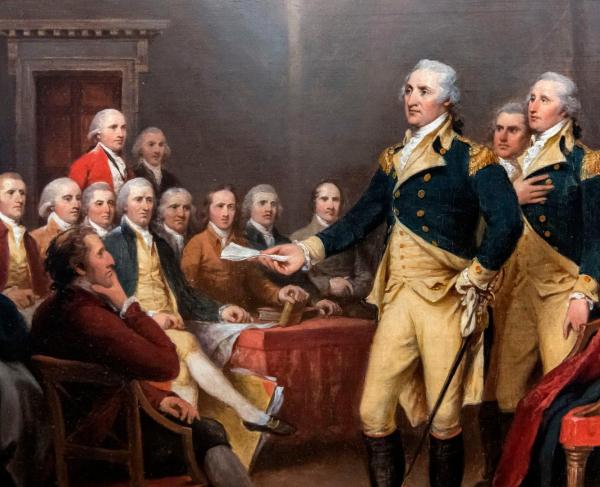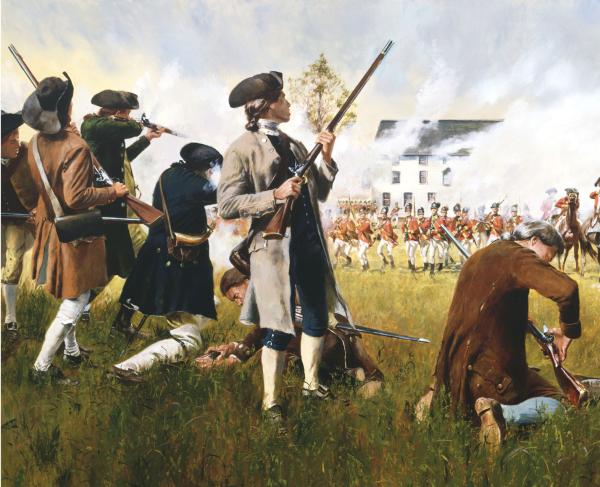
The Neilson House at Saratoga Battlefield by Samantha Decker
Fact #1: Britain’s military strategy in the north for 1777 involved a multi-pronged offensive to cut the northern states off from the rest of the colonies.
In order to cut the American colonies in half and end the war, British forces in the north launched a multi-pronged offensive towards Albany, New York, and into the Mohawk River Valley. General John Burgoyne, with his northern army of 8,000 men, and Lt. Col. Barry St. Leger, with a smaller force were to strike from the north up Lake Champlain and from the west, and capture Forts Ticonderoga and Stanwix. From there they would rendezvous south of Lake Champlain and march on Albany, as Gen. Henry Clinton marched north up the Hudson clearing all major resistance in the northern states. Further to the south, General William Howe’s army advanced to capture the American political capital of Philadelphia. If both offensives succeeded, it very well could have spelled doom for the cause of liberty.
Fact #2: The British suffered major setbacks during the siege of Fort Stanwix and the battle of Bennington.
Delays and setbacks plagued the British advance into the New York interior throughout the campaign. After capturing Fort Ticonderoga in early July, Burgoyne chose to pursue the retreating American forces rather than advancing directly toward Albany. This cost him valuable time and resources. For several weeks he dallied at Skenesborough, at the southern end of Lake Champlain, attempting to remedy an increasingly stretched out supply line. His advance thereafter was stalled by destroyed provisions and road obstructions created by Patriot forces.
Things took an even greater turn for the worse when on August 16 a major foraging party was bludgeoned at the Battle of Bennington. The British loss was some 900 men killed, wounded, and mostly captured. It was a massive piece of Burgoyne’s army he could not get back. Less than a week later, St. Leger’s force was stopped short at Fort Stanwix in the Mohawk River Valley. “Gentleman Johnny” was on his own.
Fact #3: Horatio Gates did not take command of the American Northern Department and replace Phillip Schuyler until August 4, 1777.
When the Saratoga Campaign began, the American Northern Department was under the command of Major General Phillip Schuyler. Schuyler was an immensely talented administrator and logistician, and he was instrumental in organizing the defense of New York against another British offensive the previous year. However, he was known to be very cautious, a trait that frustrated many of his subordinates. When Fort Ticonderoga capitulated on July 6, Congress searched for a scapegoat, and Schuyler was officially relieved of his duties and replaced with Major General Horatio Gates in August. Upon his arrival, Gates worked tirelessly to recruit militia and bolster the size of his army to eventually double that of Burgoyne’s.
Fact #4: The first engagement at Saratoga, fought September 19, 1777, is known as the battle of Freeman’s Farm and was a bloody affair for the British.
The first battle of Saratoga was fought on the farm of Loyalist John Freeman, north of the main American line on Bemis Heights. Several days prior, Burgoyne’s army had crossed to the western side of the Hudson River and was prepared to push south and breakthrough Gates’s line and advance to Albany. On the morning of September 19, 1777, the British drove south in three columns. Before 1 pm, the advance guard ran into American riflemen commanded by Colonel Daniel Morgan. For the rest of the day, troops on both sides were fed into the maelstrom. As darkness fell, the Americans extracted themselves from the battlefield and retired to their lines on Bemis Heights. Although the British held the field, it had come at a significant cost. Over 600 men had been lost. The 62nd Regiment of Foot alone had sustained 210 casualties—well over half the regiment. Burgoyne’s army continued to shrink and overall success was still out of reach. If he was going to reach Albany, he would quickly need to deliver a decisive blow to the Americans before his army melted away.
Fact #5: Major General Benedict Arnold was completely omitted from Gates’s report to Congress regarding the battle of Freeman’s Farm.
Benedict Arnold and Horatio Gates worked very well with each other prior to the Saratoga Campaign. They respected each other and together helped halt the British invasion from Canada the previous year. However, their relationship soured in the weeks leading up to the battle of Freeman’s Farm, and Arnold, whose division was engaged with Burgoyne and he, himself, was responsible for feeding reinforcements into the fight, was completely omitted from Gates’s report to Congress on September 22. Upon learning this, Arnold stormed into Gates’s headquarters and immediately an argument of “high words and gross language,” erupted between the two. Arnold stormed out, but the damage had been done. Gates restructured his army and stripped Arnold of his wing command, effectively leaving him with no troops to command in the Northern Department.
Fact #6: The battle of Bemis Heights, fought on October 7, 1777, was the decisive engagement of the battle of Saratoga and the campaign.
The battle of Bemis Heights was the second major engagement at Saratoga. Like at Freeman’s Farm, the battle began with a British reconnaissance-in-force that escalated into a general action. The fighting was bloody and desperate, and things began to unravel for the British when Brigadier General Simon Fraser was mortally wounded by an American musket ball (not fired by Timothy Murphy as tradition has held). British and German troops made a stand in the Balcarres and Breymann Redoubts as waves of American soldiers pushed forward against them. Benedict Arnold, though without a command, was on the field leading the men into the fight. At the climax of the battle, Arnold led an attack into the rear of the defenders of the Breymann Redoubt. The assault succeeded, as the Americans captured the works, but Arnold was severely wounded when his left leg was smashed by an enemy ball and his horse was killed, tumbling and pinning him to the ground. Burgoyne ordered his army to retire to the Great Redoubt closer to the Hudson River. The field belonged to the Americans.
Fact #7: The battle of Bemis Heights was the last time Benedict Arnold commanded Patriot troops on a battlefield.
October 7, 1777, was the last time that Benedict Arnold commanded Patriot troops on the battlefield. The grievous wound to his left leg, the same leg he had been wounded in during the battle of Quebec in 1775, left him incapacitated for many months in a crammed Albany army hospital. Though doctors recommended that the limb be amputated, Arnold refused to allow them. Multiple surgeries left it two inches shorter and he forever walked with a limp. Although Gates did not leave Arnold out of his report this time and Congress finally restored his rank as a senior major general in the army, he had approached a point of unlikely return in regard to his commitment to the cause. By mid-1778, Arnold recovered enough to resume his service, but he was unable to lead troops in the field. When the British evacuated Philadelphia in June 1778, George Washington appointed Arnold Military Governor of Philadelphia. It was then that his downward spiral toward treason quickly accelerated. The next time he marched at the front of men onto a battlefield, it was wearing a scarlet coat.
Fact #8: Burgoyne did not immediately surrender his army following the battle of Bemis Heights.
Burgoyne did not immediately surrender his army following the defeat at the battle of Bemis Heights. Instead, the next day he pulled his army out of its defenses and trudged north to Saratoga (present-day Schuylerville, New York) with the hope that his force may be saved. With his supplies dwindling, however, Burgoyne ordered his men to dig in. By October 12, the American army had surrounded him and five days later, Burgoyne surrendered.
Fact #9: The British and Hessian prisoners remained in America until the end of the war.
As part of the Convention of Saratoga, the terms agreed upon between Burgoyne and Gates allowed for the British and German soldiers to return to Europe under the promise that they would not return to fight in the conflict again. The “Convention Army,” as the prisoners were dubbed, was marched toward Boston, Massachusetts, which would serve as its place of departure from America. For several months the men were held there until early 1778 when the Continental Congress revoked the terms of the surrender. The Convention Army was marched to Charlottesville, Virginia, and afterward to Frederick, Maryland, where they were to remain until properly exchanged. For the prisoners, they would not return home until peace was officially declared in 1783. By then, thousands had grown sick or escaped captivity, many settling in America and starting a new life.
Fact #10: The victory provided France with added confidence to militarily support the Americans.
The surrender of Burgoyne’s army was a massive victory for the American cause on the international stage as well. France, the centuries-old enemy of Britain, received the reassurance that the American cause would be worth openly supporting. On February 6, 1778, American and French diplomats agreed to and signed the Treaties of Alliance and Amity and Commerce. Covert material aid that had been provided since 1776 now became open material and military aid. It was the turning point of the American Revolution. British strategy in America shifted, as more valuable possessions like the West Indies became a priority to protect. The entry of France into the conflict had capped off the victory at Saratoga. While 1777 was otherwise a dark year, especially for George Washington’s army, 1778 began on a high note.
Related Battles
330
1,135


